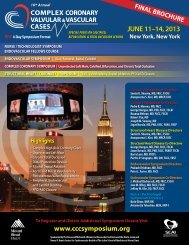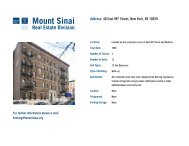Organ Donation - Mount Sinai Hospital
Organ Donation - Mount Sinai Hospital
Organ Donation - Mount Sinai Hospital
- No tags were found...
You also want an ePaper? Increase the reach of your titles
YUMPU automatically turns print PDFs into web optimized ePapers that Google loves.
ORGAN DONATION:<strong>Donation</strong> after Neurologic Death<strong>Donation</strong> after Cardiac DeathJennifer Frontera, MDNeurocritical Care
Neurocritical Care Boards• 15 yo M involved in a MVA presents withextensive head injury. His neurologicalexam is notable for near brain death withthe exception of corneals. His parentswant to withdraw care but have alwaysbeen supporters of organ donation andmention this to you.
Question• Do you:1. Withdraw care2. Wait for him to become brain dead3. Alert your OPO that you have a potentialDCD case4. Continue with aggressive care
As of 6/16/0899,049CandidatesOn waiting list18 patientsDie each dayAwaiting transplantUNOSAll the rest of usFrom 1/07-12/0714,395 donorsAnd 28,534transplantsUNOS.org
Types of Donors• <strong>Donation</strong> after Neurologic Death (DND)• Extended Criteria Donor (ECD)– Age >60– Age 50-59 PLUS 2 of 3: stroke as cause of death,HTN, Cr>1.5• <strong>Donation</strong> after Cardiac Death (DCD)– Patients with catastrophic brain injury with intent towithdraw life support are potential organ donors– Expected death within 60 min. of withdrawl of lifesupport• Tissue <strong>Donation</strong> (cornea, skin, bone,musculoskeletal)
Steinbrook NEJM 2007
Steinbrook NEJM 2007
Contraindications to <strong>Donation</strong>• MSOF due to sepsis• History of cancer EXCEPT:– Skin cancer other than melanoma– certain primary brain tumors– remote prostate cancer• Infections:– Viruses: HIV, HTLV I/II, rabies, reactive HbSAg, measles,rabies, west nile , SARS, adenovirus, enterovirus andparvovirus, active: HSV, VZV, EBV– Viral encephalitis/meningitis– Fungal: active cyptococcus, aspergillus, histoplasma,coccidoides, candidemia, invasive yeast infection– Bacterial: TB, gangrenous bowel, perf’d bowel, intraabdominalsepsis– Parasites: trypanosoma, leishmania, strongyloides, malaria– Prion disease• Hep B or C donors can transplant into those with same virus orthose in dire need of transplant• CMV + can be transplanted, better success with prophylaxis Wood NEJM 2004
<strong>Donation</strong> after NeurologicalDeath
Definition of Brain Death• Brain death= legal death• Irreversible loss of brain and brainstemfunction• No universal policy to declare brain death-varies hospital to hospital• NYS Dept of Health guidelines for age>1year• Top diagnoses leading to brain death– SAH– TBI– Others: ICH, HIE, stroke
Diagnosing Brain Death• Primarily clinical diagnosis• 2 exams 6 hours apart for adults• Includes testing brainstem reflexes and asingle apnea test• If cannot complete apnea test orquestionable exam findings, a confimatorytest must be performed
Clinical Criteria Necessary beforediagnosing Brain Death1. Diagnosis compatible with brain death exam2. Must exclude confounding medical conditions:– no severe acid-base abnormality,– electrolyte or endocrine disturbance3. No drug intoxication, poisoning or neuromuscularblockade– beware with patients on propofol- can accumulate– check Utox if on barbituates/versed/fentanyl– Reverse neuromuscular blockade withneostigmine/glycopyrollate, check train of four– if known drug cannot be quantified pt should be observed for4x half life of drug OR confirmatory test4. Pt must not be hypothermic or hypotensive:Core temp ≥32°C and SBP ≥ 90 mmHg if ≥18 yo
Who can perform brain deathexam?Trainee must be PGY 3 or higher2 exams 6 hours apart, no brainstem reflexes, no response to pain
Exam findings compatible withbrain death• Spinal reflexes seen in 33-75% of patients• Triple flexion• Reflexes including babinski• Undulating Toe (flexion/extension)• Semi-rhythmic facial mvmt (denervated 7 th )• Finger flexor movement• Tonic neck flexion (passive neck movement->stereotyped trunk or extremity movement, fencerposturing)• Lazarus• Opisthotonus• Sweating, flushing, tachycardia• Blood pressure swings• Respiratory like movements without significant TV
NO!
Apnea Test• Prerequisites:– Core temp ≥36.5°C– Options:• euvolemia,• PCO2>40 mmHg,• PO2>200 mgHG• Complications in up to 26% of pts- more frequent wheninadequate preoxygenation, acid/base/electrolyteabnormalities, preexisting arrhythmia• CO2 rise occurs at about 3 mmHg per minute• If PCO2>60 mmHg or 20 mmHg increase over baselineand• NO respiratory movement= supports brain death
Confirmatory testing• Often necessary when:– Severe facial or C-spine trauma– Surgical pupils or preexisting pupillary abnormality– Sleep apnea or COPD with chronic CO2 retention– Toxic levels of• sedatives,• aminoglycosides,• tricyclic antidepressants• Anticholingergics• Chemo• Neuromuscular blockade
Confirmatory testsBilateral insonation ant and posteriorSensitivity 91-99%, Specificity 100%10% of patients have notemporal windowsAnterior and posterior injection
Confirmatory tests• EEG Criteria:– >2 microV sensitivity– Between 1-30 Hz– 30 minutes of recording– Minimum of 8 electrodes,distance 10 cm apart– Impedence between 100-10,000 Ώ• Technetium SPECT-Tc99• Absent B N20-P22– Less useful withneuropathy or primarybrain stem pathologyWijdicks NEJM 2001
Notification of next of kin• Physician is responsible to notify next ofkin• Consent not needed to perform or declarebrain death• However, reasonable accommodationsshould be made for religious or moralfamily beliefs• Ethics and palliative care can offerguidance• Life support should be continued for areasonable amount of time based on familywishes
Approaching family for organ• Notify NYODN if:donation– impending brain death is suspected– If withdrawal of care is planned– after all deaths for potential tissue donation• NYODN, rather than the physicans caringfor patient, should reach out to the family• NYODN typically reaches out after 2 ndbrain death exam and apnea test confirmbrain death
Care for the potential organ• Progression from braindeath to somatic deathresults in loss of 10-20%of potential donors• Intensive monitoring andcare needed to preserveorgans• Aggressive managementwith bronchoscopy,hormonal therapy andhemodynamic monitoringand managementimprove organprocurement rate(Kutsogiannis Can J Anesthe2006)donor
SCCM Board Review• A 27 yo W is brought to the ED after being foundobtunded.• She was observed to be walking on a street andsuddenly collapsed.• A severe SAH was diagnosed by CT. She isadmitted to the ICU.• Upon examination, you find that she has nobrainstem reflexes; you suspect that she meetsbrain death criteria. You confirm this later withan apnea test.
SCCM Board Review• The patient’s family is aware of the gravityof the prognosis and is in transit to yourhosptial. You are called to the bedsidebecause the patient is markedlyhypotensive. Physical exam reveals coolextremeties and the SBP is 70 mmHg
Question:• Which one of the following should you do next?1. Pronounce the patient dead and discontinuemechanical ventilation2. Write an order for no escalation of current therapy andwithhold resuscitative efforts when cardiac arrestensues3. Call for a consult from a physician from theneurosciences in order to corroborate your clinicalimpression of brain death.4. Consider organ donation and insert a PAC, titrating thepatient’s cardiovascular support to indices of cardiacfilling pressure, CI and MAP while awaiting the family’sarrival.
Effects of brain death• Medullary level of braindeath producessympathetic surge– elevated MAP to maintainCPP (in face of elevatedICP)• cardiac stunning,myocyte necrosis• Spinal cord ischemiacoincides with herniationresulting in deactivationof sympathetic nervoussystem
Change in pituitaryFunction with braindeathHypotensionDiabetes InsipitusCardiac Stunning
Hormonal therapy• Thyroxin, Vasopressin, Solumedrol andInsulin• Reduces Cardiovascular lability• Reduces EKG abnormalities• Reduces acid-base disturbances• Improves transplant rates(Novitzky Transplantation 1987, Novitsky Transplantation 1988)
Evidence for hormonal therapy• Prospective study of 19 hemodynamicallyunstable brain dead patients• All were refractory to volume resusitation,inotropes and pressors• Received levothyroxine (T4) drip 20 mcgbolus and 10 mcg/h with solumedrol,insulin and D50• Significant reduction in vasopressorrequirement• 53% had complete discontinuation ofother pressors Salim Archives Surgery 2001
Evidence for hormonal therapy• Retrospective study 10,292 brain dead donors• HR of UNOS pathway: T3 4 mcg bolus and 3mcg/h, insulin 1 u/h to BG 120-180, Pit 1 u bolusand 0.5 u/h• Univariate analysis:– Those with HR yielded 22.5% more organs,P
Evidence for hormonal therapyHormonaltherapyNo hormonaltherapygraft loss• UNOS study of 4543heart recipientsgraftdysfunction3.8% 5.6%7.9% 11.6%• 46% reduced odds ofdeath in 30 days Rosendale, Am J Transplant 2002P=0.01
DON’T READ THIS!
Hemodynamic Goals• MAP≥60 mmHg• CI ≥2.4 L/min.• UOP ≥1.0 cc/kg/h• LV EF ≥45%• Normal pH• WATCH out – 80% of brain dead patientare hypotensive(Nygaard J Trauma 1990)
Care for the potential organdonor• STEP #1: Assess hemodynamic status• Is patient hemodynamically unstable?• Bolus with 10 cc/kg of NS, continue to goalSBP>90 mmHg or MAP>60 mmHg and UOP>1cc/kg/h• Use colloids if patient actively bleeding (pRBC,FFP etc)• Ensure central line and A line in place• Begin vasopressors if necessary and beginhormonal therapy (if pt has 1 st brain death exam)• Order TTE
Care for the potential organ donor-Hormonal Resusitation• STEP #2: Treat endocrine failure/panhypopituitary state• Synthroid drip• Pitressin drip 25 u in 250 cc NS– 1 u Pitressin bolus– 0.5 u /h titrate to max of 4-6 u/h• Insulin drip to maintain BG 80-150 mcg/dL• Start 15 mg/kg Methylpresnisolone q 24 h• For all brain dead patients
Care for the potential organdonor• DI watch:– Check for UOP ≥5 cc/kg/h x 2 hours– Urine specific gravity 145– Serum Osm >305– In absence of diuresis or contrast• If DI detected->Pitressin 0.5 u IV titrate toUOP 1-2 cc/kg/h, max 4-6 u/h• Avoid D5W- hyperglycemia causesosmotic diuresis and worsens problem
Special Consideration: Cardiac• Check TTE• If EF
Heart <strong>Donation</strong>• Need cardiac cath• Cath and bronch areconsideredemergencyprocedures andshould not be delayed• Longer medical careled to lower yield ofcardiac allograft(Cantin Transplantation2003)
Special Considerations: Lung• Rate of lung recoverylower than otherorgans• Solumedrol 15 mg/kgled to betteroxygenation and lungyield than nonsteroidtx pts(Follette J Heart Lung Transplant1998)• Early donor networkcontact and steroidspredict lung donation(McElhinney Clin Transplant2001)
Lung donation• TV 8-10cc/kg, 6 cc/kg ifALI/ARDS• Avoid atelectasis with PEEP≥5• Solumedrol 15 mg/kg qd• Empiric Zosyn• Adjust vent per ABG• Need bronch• Daily CXR• Need PF ratio >300,• plateau press
Lung Recruitment• If decreased pO2 or CXR withatelectasis:• Increase PEEP to 30 x 30seconds (dial up over 5-10seconds)• Return to previous setting andrepeat in 5 min.• Recruitment strategy notshown useful in ALI/ARDSpatients (Meade JAMA 2008)• Perform post bronch andapnea test• Beware temporaryhypotension with increasedPEEP• Bronch for mucous plugging asneeded- do not do washings
Data on lung strategy• Early bronch, frequent suctioning,targeting ventilation at lung expansion• Increase lung procurement(Gabbay J Resp Crit Care Med 1999,(Gabbay J Resp Crit Care Med 1999,Cummings J Transplant Coordination1995)
<strong>Donation</strong> after Cardiac Death
Definition• Cardiac death “irreversible cessation of cardiacand respiratory function”• Brain death “Irreversible loss of function of theentire brain, including the brain stem”• ¾ of organs transplanted are recovered fromdeceased donors.• Typical DCD donors have devastatingneurologic injury but have not progressedtoward brain death• Or have terminal illness and wish terminal wean
Outcomes• <strong>Organ</strong>s transplanted from DCD havesimilar outcomes to DND• 30 min. from death to liver harvest• 60 min. for kidney, pancreas
“In the most shockingaccusation, the complaintsaid Dr. Roozrokh introducedBetadine, a topical antisepticInto Mr. Navarro’s system”-NY TimesPatient did not dieFor several hours<strong>Organ</strong>s not harvestedCivil suit Settled for $250,000Felony Criminal Charges:Dependent Adult AbuseMingling a harmful substancePrescribing a controlledSubstance without medicalpurpose
Process1. Decision to withdraw treatment2. Assessment for DCD3. Withdrawal of treatment4. Pre-mortem interventions (morphine dripetc)5. Cardiac arrest and organ retrieval
Revised in accordance with DOH letter dated April 2007
1. Decision for Withdrawal of LifeSustaining Therapy• Family/patient decides based on patient wishesto withdraw care• This occurs prior to any discussions regardingorgan donation- there should be a clearseparation between withdrawal and donationdiscussions• Only NYODN staff should approach the familyfor donation discussions• DNR should be documented• Withdrawal conversation documented
2. Eligibility for DCD• Contact NYODN (MD, RN)• NYODN will assess patient for DCD• No family discussion re:DCD will occuruntil NYODN has determined suitability fortransplant
3. NYODN approves suitability• NYODN coordinator approaches family and explainsprocedure and transplant process• If consent obtained, pt assessed for likelihood of arrest in1 hour• Patient disconnected from vent (SBP or PS 5) for up to10 min. and VS monitored• Patient may receive heparin during procurement andfamily should be informed• Other procedures prior to transfer to OR (lines etc) solelyto promote organ preservation are discouraged• If pt not likely to arrest in 60 min. family informed- maybe reasonable to proceed to OR anyway
4. Consent• NYODN consent form used and placed on chart• NYODN obtains consent, answers questions,informs family about possible heparin use• Family informed that if pt does not arrest in 60min. after withdrawal, he/she will be returned toICU bed• Health care agents can consent to pre-mortemprocedures to the extent that these arecomenserate with pt’s wishes• Copy of consent placed in chart
5. Transferring patient to OR• NYODN will arrange time of organ recoverybased on:– Family’s wishes– OR schedule– <strong>Organ</strong> recovery team• OR nursing director/coordinator will be notified• The anesthesia attending on call will be notifiedand briefed by attending physician or designeeprior to transfer to OR• Anesthesia team should be aware that primarycare team may administer comfort care meds inOR
5. Transferring patient to OR• The patient transported to the OR by the ICUnurse, primary team• If the patient has a cardiac arrest prior to transferto the OR- no CPR• Orders prior to OR:– Continue meds from ICU– Order for transport, monitoring and sedative/painmeds– Order for heparin– Additional meds for comfort procured from ICU/PACUnurse or anesthesia
5. Transferring patient to OR• The family may accompany pt to OR butmust leave after patient declared dead• A space should be made in OR for familymembers who wish to be present• Bed must be saved in ICU or floor in thecase that the patient does not arrest
6. OR care• Patient will be prepped and draped prior toextubation to minimize ischemia time• This will be explained to the family as part of theconsent process• The organ harvesting team will leave the ORafter patient preparation and will not return untilafter death is declared and the family has left theOR• Any physician or staff member with ethicalobjections may decline to participate in DCD butshould find a replacement
6. OR Care• Titration of sedation pre and post extubation may bemade jointly by ICU team,or anesthesia• Sedative/analgesic drips begun in ICU may be continuedor may be initiated in OR• Titration of drips should not be influenced by possibilityof organ donation• Suggested titration targets include HR
6. Pronouncement of Death• 5 min. must pass after cardiopulmonary arrestbefore legal declaration of death• Must arrest within 60 min. of withdrawal• Pronouncement of death may be made byprimary care team (attending or designee), oranesthesia• The declaring physician must not be part oforgan retrieval/transplant team• Death certificate must be filled out• Family notified
7. Patients Found Ineligible• If no cardiac arrest in 60 min. pt returns toICU or floor bed and comfort carecontinues• If pt expires in ICU or on floor primary• If pt expires in ICU or on floor primaryteam must declare death and fill out deathcertificate
8. Cost• NYODN will be responsible and billed forall costs related to medical suitability andrecovery of organs.
Conclusions• There is a gap between organ supply anddemand• DND organ yield can be increased withhormonal therapy• DCD is an option for patients with plannedwithdrawl of life sustaining measures• Collaborative teamwork is necessary toprovide patient and family support duringDCD
WWW.donatelife.orgNYS organ and tissue donor registry
Care for the potential organdonor• STEP #2: Assess hemodynamic status• Is patient hypovolemic?– CVP
Care for the potential organ donor-Hormonal Resusitation• Prepare Synthroid drip– 200 mcg T4 in 500 cc NS– 20 mcg bolus– Start 10 mcg per hour (do not exceed 20mcg/h)– Titrate up/down as necessary• Give 10 u insulin with 1 amp of D50(unless BG>300) prior to initiatingsynthroid– Synthroid drip causes hyperkalemia
1. Withdrawal of Life Sustaining Therapy• Family decides based on patient wishes to withdraw care• This occurs prior to any discussions regarding organdonation• Health care agents can consent to pre-mortemprocedures to the extent that these are commiserate withpt’s wishes• Extubation will occur in the OR by the patient’s attendingphysician or designee (licensed resident or fellow)• This may be an anesthesia, critical care, palliative careor primary team attending• Any physician or staff member with ethical objectionsmay decline to participate in DCD but should find areplacement
2. Eligibility for DCD• Contact NYODN• Palliative Care consult should be called• decision for withdrawl documented by primaryteam and pall care team• NYODN will assess patient for DCD• No family discussion re:DCD will occur untilNYODN has determined suitability for transplant• Patient should be made DNR withdocumentation
3. NYODN approves suitability• NYODN coordinator approaches family and explainsprocedure and transplant process• If consent obtained, pt assessed for likelihood of arrest in1 hour• Patient disconnected from vent (SBP or PS 5) for up to10 min. and VS monitored• Patient may receive heparin during procurement andfamily should be informed• Other procedures prior to transfer to OR (lines etc) solelyto promote organ preservation are discouraged• If pt not likely to arrest in 60 min. family informed- maybe reasonable to proceed to OR anyway
4. Consent• Family informed that if pt does not arrest in60 min. after withdrawl, he/she will bereturned to ICU bed• Bed must be saved in ICU in the case thatthe patient does not arrest• The family may accompany pt to OR butmust leave after patient declared dead• A space should be made in OR for familymembers who wish to be present
5. Transferring patient to OR• NYODN will arrange time of organ recoverybased on:– Family’s wishes– OR schedule– <strong>Organ</strong> recovery team• OR nursing director/coordinator will be notified• The anesthesia attending on call will be notifiedand briefed by attending physician or designeeprior to transfer to OR
5. Transferring patient to OR• The patient transported to the OR by the ICUnurse, primary team or palliative care team• If the patient has a cardiac arrest prior to transferto the OR- no CPR• Orders prior to OR:– Continue meds from ICU– Order for transport, monitoring and sedative/painmeds– Order for heparin– Additional meds for comfort procured from ICU/PACUnurse or anesthesia
5. Transferring patient to OR• Titration of sedation pre and post extubationmay be made jointly by ICU team, palliative careor anesthesia• Sedative/analgesic drips begun in ICU may becontinued or may be initiated in OR• Titration of drips should not be influenced bypossibility of organ donation• Suggested titration targets include HR
6. Pronouncement of Death• 5 min. must pass after cardiopulmonary arrestbefore legal declaration of death• Must arrest within 60 min. of withdrawl• Pronouncement of death may be made byprimary care team (attending or designee),palliative care or anesthesia• The declaring physician must not be part oforgan retrieval/transplant team• Death certificate must be filled out• Family notified
7. Patients Found Ineligible• If no cardiac arrest in 60 min. pt returns toICU or floor bed and comfort carecontinues• If pt expires in ICU or on floor primary• If pt expires in ICU or on floor primaryteam must declare death and fill out deathcertificate
8. Cost• NYODN will be responsible and billed forall costs related to medical suitability andrecovery of organs.


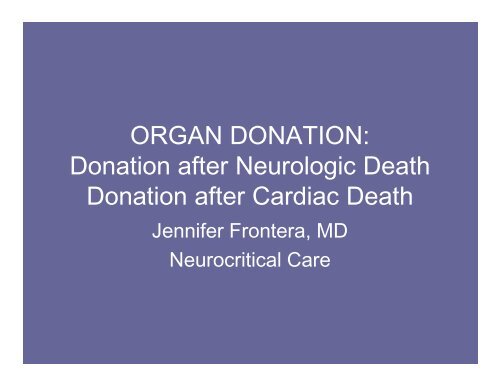
![December 2, 2012 [PDF] - Mount Sinai Hospital](https://img.yumpu.com/51092274/1/190x245/december-2-2012-pdf-mount-sinai-hospital.jpg?quality=85)
![January 21, 2013 [PDF] - Mount Sinai Hospital](https://img.yumpu.com/50916550/1/190x245/january-21-2013-pdf-mount-sinai-hospital.jpg?quality=85)

![February 3, 2013 [PDF] - Mount Sinai Hospital](https://img.yumpu.com/50584982/1/190x245/february-3-2013-pdf-mount-sinai-hospital.jpg?quality=85)
![March 18, 2012 [PDF] - Mount Sinai Hospital](https://img.yumpu.com/50462098/1/190x245/march-18-2012-pdf-mount-sinai-hospital.jpg?quality=85)
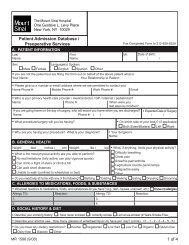
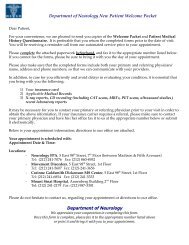
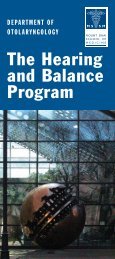
![Partners Program Guide [PDF] - Mount Sinai Hospital](https://img.yumpu.com/49411954/1/190x245/partners-program-guide-pdf-mount-sinai-hospital.jpg?quality=85)
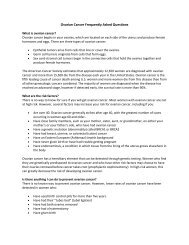
![March 19 - April 1, 2012 [PDF] - Mount Sinai Hospital](https://img.yumpu.com/48990923/1/190x245/march-19-april-1-2012-pdf-mount-sinai-hospital.jpg?quality=85)
![PGY-1 Residency Application [PDF] - Mount Sinai Hospital](https://img.yumpu.com/48577701/1/190x245/pgy-1-residency-application-pdf-mount-sinai-hospital.jpg?quality=85)
